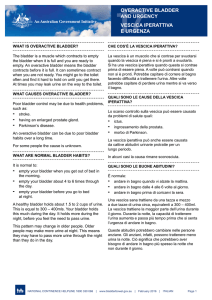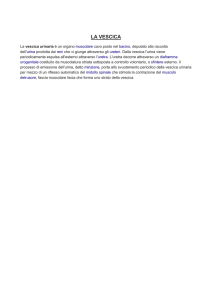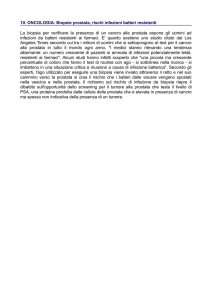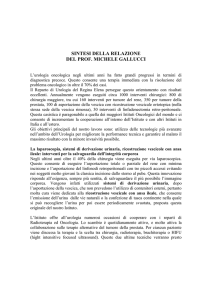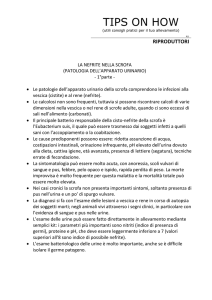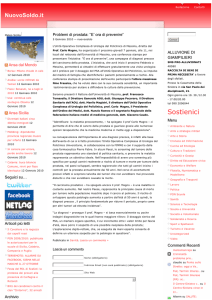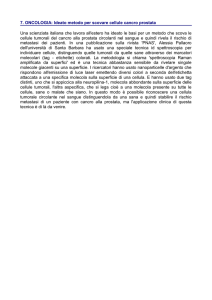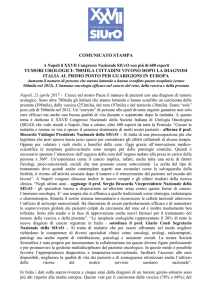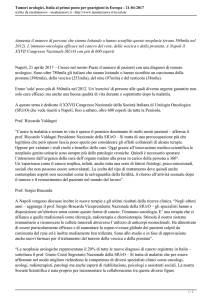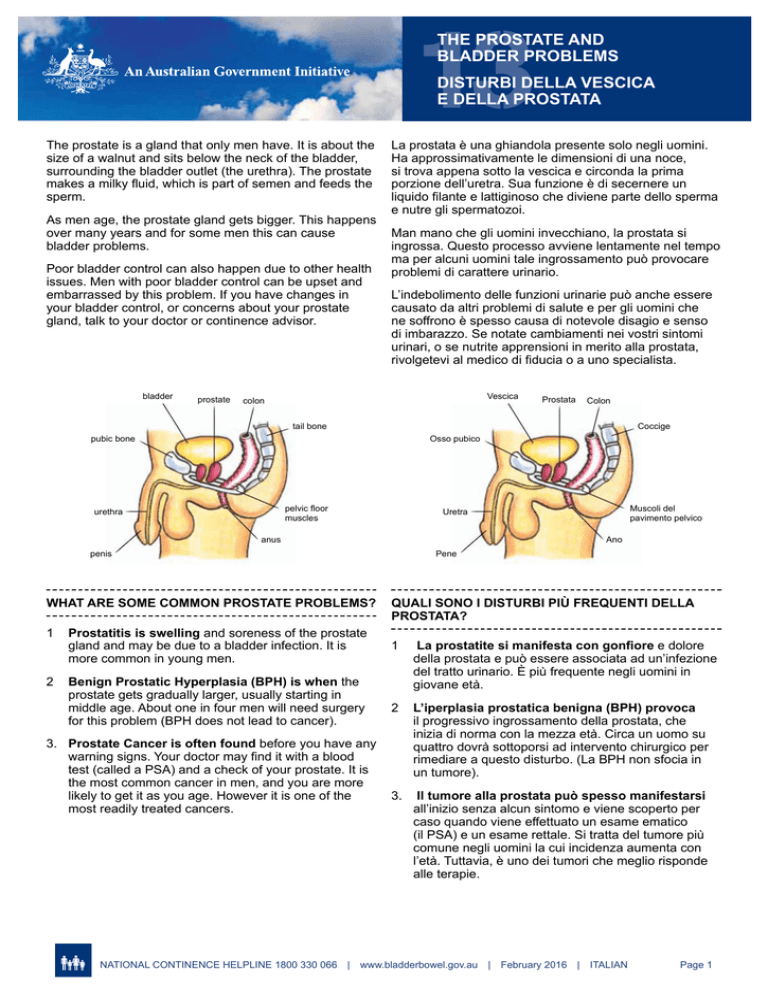
13
THE PROSTATE AND
BLADDER PROBLEMS
DISTURBI DELLA VESCICA
E DELLA PROSTATA
The prostate is a gland that only men have. It is about the
size of a walnut and sits below the neck of the bladder,
surrounding the bladder outlet (the urethra). The prostate
makes a milky fluid, which is part of semen and feeds the
sperm.
As men age, the prostate gland gets bigger. This happens
over many years and for some men this can cause
bladder problems.
Poor bladder control can also happen due to other health
issues. Men with poor bladder control can be upset and
embarrassed by this problem. If you have changes in
your bladder control, or concerns about your prostate
gland, talk to your doctor or continence advisor.
bladder
prostate
La prostata è una ghiandola presente solo negli uomini.
Ha approssimativamente le dimensioni di una noce,
si trova appena sotto la vescica e circonda la prima
porzione dell’uretra. Sua funzione è di secernere un
liquido filante e lattiginoso che diviene parte dello sperma
e nutre gli spermatozoi.
Man mano che gli uomini invecchiano, la prostata si
ingrossa. Questo processo avviene lentamente nel tempo
ma per alcuni uomini tale ingrossamento può provocare
problemi di carattere urinario.
L’indebolimento delle funzioni urinarie può anche essere
causato da altri problemi di salute e per gli uomini che
ne soffrono è spesso causa di notevole disagio e senso
di imbarazzo. Se notate cambiamenti nei vostri sintomi
urinari, o se nutrite apprensioni in merito alla prostata,
rivolgetevi al medico di fiducia o a uno specialista.
Vescica
colon
Prostata
Colon
tail bone
pubic bone
Coccige
Osso pubico
pelvic floor
muscles
urethra
anus
penis
WHAT ARE SOME COMMON PROSTATE PROBLEMS?
1
Prostatitis is swelling and soreness of the prostate
gland and may be due to a bladder infection. It is
more common in young men.
2
Benign Prostatic Hyperplasia (BPH) is when the
prostate gets gradually larger, usually starting in
middle age. About one in four men will need surgery
for this problem (BPH does not lead to cancer).
3.
Prostate Cancer is often found before you have any
warning signs. Your doctor may find it with a blood
test (called a PSA) and a check of your prostate. It is
the most common cancer in men, and you are more
likely to get it as you age. However it is one of the
most readily treated cancers.
Muscoli del
pavimento pelvico
Uretra
Ano
Pene
QUALI SONO I DISTURBI PIÙ FREQUENTI DELLA
PROSTATA?
1
La prostatite si manifesta con gonfiore e dolore
della prostata e può essere associata ad un’infezione
del tratto urinario. È più frequente negli uomini in
giovane età.
2
L’iperplasia prostatica benigna (BPH) provoca
il progressivo ingrossamento della prostata, che
inizia di norma con la mezza età. Circa un uomo su
quattro dovrà sottoporsi ad intervento chirurgico per
rimediare a questo disturbo. (La BPH non sfocia in
un tumore).
3.
Il tumore alla prostata può spesso manifestarsi
all’inizio senza alcun sintomo e viene scoperto per
caso quando viene effettuato un esame ematico
(il PSA) e un esame rettale. Si tratta del tumore più
comune negli uomini la cui incidenza aumenta con
l’età. Tuttavia, è uno dei tumori che meglio risponde
alle terapie.
NATIONAL CONTINENCE HELPLINE 1800 330 066 | www.bladderbowel.gov.au | February 2016 | ITALIAN Page 1
13
THE PROSTATE AND
BLADDER PROBLEMS
DISTURBI DELLA VESCICA
E DELLA PROSTATA
HOW DO I KNOW IF I HAVE A PROSTATE PROBLEM?
If you have one or more of these issues, you may have a
prostate problem:
trouble starting the flow of urine;
slow urine stream once started;
needing to pass urine more often through the day or
night;
leaking after passing urine, or between visits to the
toilet;
needing to pass urine again soon after going to the
toilet;
feeling an urgent need to pass urine;
burning or pain when passing urine;
blood in urine; and
feeling that the bladder is not fully empty after going
to the toilet.
Some of these problems may not be due to the prostate.
For instance, some medicines may cause the bladder to
store up urine. Your doctor or continence advisor can help
you find the cause of your problem.
HOW CAN MY PROSTATE CAUSE BLADDER
PROBLEMS
Blocking of the urethra (the urine tube): As the prostate
grows larger, it may block the bladder outlet and stop the
bladder from emptying. In some cases, urine may get
stored up until it starts to leak out. If this happens, see a
doctor straight away.
An overactive bladder can be caused by the bladder
working extra hard to get past a blockage. An overactive
bladder can tighten without your control, causing an
urgent need to pass urine. After surgery to ease the
blockage you may still have an urgent need to pass
urine, and it could get worse for a few weeks, until the
bladder goes back to normal.
COME FACCIO A CAPIRE CHE HO UN DISTURBO
ALLA PROSTATA?
Se presentate uno dei seguenti sintomi o una
combinazione degli stessi potreste avere un problema
alla prostata:
difficoltà ad avviare il flusso dell’urina;
flusso lento dell’urina una volta iniziata l’urinazione;
bisogno di urinare più spesso del solito durante il
giorno o di notte;
piccole perdite dopo l’urinazione o tra una visita e
l’altra in bagno;
necessità di urinare a breve intervallo dall’urinazione
precedente;
sensazione di bisogno urgente di urinare;
bruciore, disagio o persino dolore durante
l’urinazione;
sangue nelle urine; e
sensazione che lo svuotamento non è completo.
Alcuni di questi disturbi non sono necessariamente
associati alla prostata. Vi sono infatti alcuni farmaci che
possono causare ritenzione urinaria. Rivolgetevi al vostro
medico o specialista per scoprire la causa del vostro
problema.
IN CHE MODO LA PROSTATA PUÒ CAUSARE
DISTURBI ALLA VESCICA?
L’ostruzione dell’uretra (canale uretrale): quando la
prostata si ingrossa potrebbe provocare un’ostruzione del
canale uretrale e impedire lo svuotamento della vescica.
In alcuni casi la ritenzione dell’urina diventa tale che
l’eccesso di urina trabocca causando un disturbo che
richiede immediate cure mediche.
La vescica iperattiva potrebbe manifestarsi a seguito
dell’aumento dello sforzo da parte della vescica per
superare la resistenza alla fuoriuscita dell’urina.
La vescica iperattiva può contrarsi involontariamente
creando il bisogno urgente di urinare. Dopo avere curato
l’ostruzione alla fuoriuscita dell’urina con un intervento
chirurgico il bisogno urgente può permanere e anche
peggiorare per alcune settimane finché la vescica torna
in condizioni normali.
NATIONAL CONTINENCE HELPLINE 1800 330 066 | www.bladderbowel.gov.au | February 2016 | ITALIAN Page 2
13
THE PROSTATE AND
BLADDER PROBLEMS
DISTURBI DELLA VESCICA
E DELLA PROSTATA
Surgery for prostate problems can damage the muscle
and nerves of the bladder outlet in a few cases. This can
cause poor bladder control. If it occurs it is almost always
short-lived, though major surgery for prostate cancer
can lead to long term bladder control problems.
L’intervento chirurgico alla prostata può talvolta
causare lesioni muscolari e nervose allo sbocco vescicale
che potrebbe causare l’incontinenza. Tale incontinenza
può essere di breve o lungo termine e dipende dalla
portata o gravità dell’intervento chirurgico.
HOW CAN POOR BLADDER CONTROL BE
TREATED?
COME SI PUÒ CURARE L’ INCONTINENZA?
First, your doctor or continence advisor will want to look
for the causes of your poor bladder control, such as
prostate disease, infection, diabetes or some medicines.
There are a few ways that poor bladder control due to
prostate disease can be treated.
1. Check up with your doctor
Il vostro medico o specialista indagherà prima di tutto
le probabili cause dei vostri sintomi ossia i disturbi della
prostata, le infezioni, il diabete e l’uso di alcuni farmaci.
Vi sono varie misure che si possono intraprendere per
curare l’incontinenza associata a disturbi alla prostata:
1. Parlatene con il medico
After a talk with your doctor, you may feel that you do not
need any treatment. Poor bladder control can get better
with time, or with simple changes to your daily habits
(See the leaflet “Good Bladder Habits for Everyone”).
Dopo averne parlato con il medico, potreste ritenere di
non avere bisogno di cure. Talvolta i sintomi migliorano
spontaneamente con l’andare del tempo oppure con
semplici modifiche delle abitudini giornaliere (Leggete
l’opuscolo “Buone abitudini urinarie”).
2. Medicines
2. Farmaci
There are a number of medicines that can help with
bladder control. Ask your doctor about these.
Vi sono vari farmaci che sono efficaci per l’incontinenza.
Consultate il vostro medico.
3. Prostate Surgery
3. Intervento chirurgico della prostata
If your prostate is the problem, then surgery can remove
all or part of the gland. The type of surgery will depend on
the size of the prostate gland.
Se il vostro problema è la prostata, l’intervento rimuove
una parte o tutta la ghiandola. Le dimensioni della
prostata determinano il tipo di intervento chirurgico
richiesto.
4. Bladder Training
A program of bladder training can help the bladder to
hold more urine without leaks or urgent feelings, even for
those with an overactive bladder.
5. Pelvic Floor Muscle Training
Pelvic floor muscle training builds up the muscles that
control how well the bladder and bowel work. Learn how
to train your muscles before surgery and start as soon
as you can after surgery (See the leaflet “Pelvic Floor
Muscle Training for Men”).
4. Esercitazione della vescica
Un programma che mira a migliorare il controllo della
vescica, aumentare la quantità di urina trattenuta senza
sostenere perdite di urina o senso di urgenza anche per
chi soffre di vescica iperattiva.
5. Esercizi del pavimento pelvico
Questi rafforzano i muscoli che controllano la funzione
della vescica e l’evacuazione. Imparate gli esercizi prima
dell’intervento chirurgico e poi iniziate a farli appena vi
sentite a vostro agio. (Leggete l’opuscolo “Esercizi del
pavimento pelvico per gli uomini”).
NATIONAL CONTINENCE HELPLINE 1800 330 066 | www.bladderbowel.gov.au | February 2016 | ITALIAN Page 3
13
THE PROSTATE AND
BLADDER PROBLEMS
DISTURBI DELLA VESCICA
E DELLA PROSTATA
6. Continence Products
6. Accessori per l’incontinenza
There is a wide range of continence products to help
cope with urine leaks (See the leaflet “Continence
Products”).
Esiste una vasta gamma di accessori per l’incontinenza
che possono essere di aiuto per far fronte alla perdita
di urina. (Leggete l’opuscolo “Prodotti e Accessori per
l’Incontinenza”).
Make sure you know enough about what the problem is,
what treatments there are, how well they work, and what
might go wrong, so that you can choose the treatment
that is best for you, with your doctor’s help.
SEEK HELP
Qualified nurses are available if you call the
National Continence Helpline on 1800 33 00 66* (Monday
to Friday, between 8.00am to 8.00pm Australian Eastern
Standard Time) for free:
Information;
Advice; and
Leaflets.
If you have difficulty speaking or understanding English
you can access the Helpline through the free Telephone
Interpreter Service on 13 14 50. The phone will be
answered in English, so please name the language you
speak and wait on the phone. You will be connected
to an interpreter who speaks your language. Tell the
interpreter you wish to call the National Continence
Helpline on 1800 33 00 66. Wait on the phone to be
connected and the interpreter will assist you to speak with
a continence nurse advisor. All calls are confidential.
Visit bladderbowel.gov.au or continence.org.au/otherlanguages
* Calls from mobile telephones are charged at applicable rates.
Informatevi sufficientemente sul disturbo, le terapie
disponibili, la loro efficacia ed eventuali problemi in modo
da poter scegliere la terapia più adatta al vostro caso,
con l’aiuto del vostro medico.
CHIEDETE AIUTO
Infermieri qualificati sono disponibili gratuitamente
chiamando il servizio di assistenza telefonica nazionale
per la continenza (National Continence Helpline) al
numero verde 1800 33 00 66* (dal lunedì al venerdì, dalle
8.00 alle 20.00 (Australian Eastern Standard Time):
Informazioni;
Consigli; e
Opuscoli.
Se avete difficoltà con l'inglese potete contattare la
Helpline tramite il servizio di interpretariato telefonico al
numero 13 14 50. Un operatore risponderà in inglese,
voi dovete dire la lingua che parlate e dovete rimanere in
linea. Successivamente verrete messi in comunicazione
con un interprete che parla la vostra lingua al quale
dovete comunicare che desiderate chiamare la National
Continence Helpline al numero 1800 33 00 66. Rimanete
in linea e l'interprete vi assisterà a parlare con un
consulente per la continenza. Le chiamate sono riservate.
Visitate il sito bladderbowel.gov.au oppure
continence.org.au/other-languages
* Le chiamate dal cellulare sono addebitate secondo le tariffe applicabili.
NATIONAL CONTINENCE HELPLINE 1800 330 066 | www.bladderbowel.gov.au | February 2016 | ITALIAN Page 4


